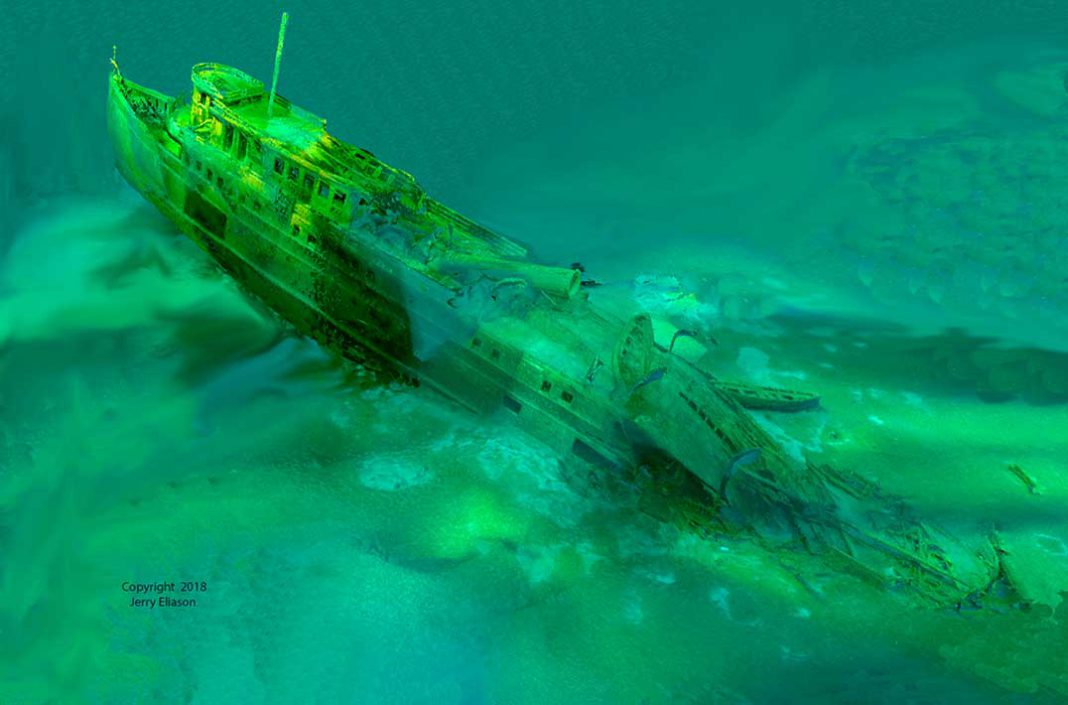OWEN SOUND—The amazingly intact wreck of the steel steamer Manasoo tragically lost in a storm on September 15, 1928, with 16 of the 21 people on board, three of whom were from Manitoulin, more than 100 head of cattle, and a 1927 automobile, has been located in deep water. Resting at an unusual angle in southern Georgian Bay near Owen Sound, the ship was found by an international team of searchers/divers.
The Manasoo spent the first 39 of its 40 years named the Macassa, carrying tourists and cargoes between Toronto and Hamilton on Lake Ontario. Built at Glasgow, Scotland in 1888, this 178 foot-long (54 metre) ship steamed across the Atlantic Ocean, arriving at Hamilton on June 7, 1888. In early 1928, the ship was purchased by the relatively new Owen Sound Transportation Company (which today operates the famous Chi-Cheemaun ferry between Tobermory and Manitoulin Island, and the Pelee Island ferries on Lake Erie). Placed mainly on the Manitoulin Island to the Soo (Sault Ste. Marie) run, the refurbished vessel was renamed the Manasoo, reflecting its chief harbor stops.
But the Manasoo proved to be a classic example of the bad luck that will plague a vessel, according to sailors’ superstition, after its name has been changed.
The Manasoo was having a very successful first season under its new name and ownership when disaster struck. Departing Manitowaning on Manitoulin Island on September 14, 1928, with 17 crew, four passengers and 116 head of cattle, heading towards Owen Sound on the southern mainland of Georgian Bay, the ship nearly reached its destination when it encountered heavy seas at 2 am. The vessel started settling in its stern and, the captain quickly realizing that something was going terribly wrong, headed his ship to the nearest land, namely the Griffith Island Lighthouse off the ship’s starboard side. But the ship sank before it could be run onto shore.
Five survivors (the captain, three sailors, and one passenger) drifted on a life raft for 60 hours before being rescued by the passing steamer Manitoba. Sixteen lives and all the cattle on the Manasoo perished. The cause of the sinking remained unexplained, with the shifting of the cattle cargo said to be at least partially to blame.
Three of the dead came from Manitoulin. Joseph Mansour was a 21-year-old waiter from Little Current and cousins Ely Shawana, age 17, of Sheguiandah and Ambrose Shawana, age 16, of Manitowaning were both deckhands on the ship.
Ken Merryman and Jerry Eliason, both from Minnesota, and Cris Kohl of Windsor, located the Manasoo in just over 200 feet of water on June 30, 2018. All three have considerable experience in finding and identifying shipwrecks in the Great Lakes.
“The very unique thing about the wreck of the Manasoo,” offered Ken Merryman, “is that it sits on the lake bottom on the very same dramatic angle at which it sank! The stern, where most of the damage occurred, is embedded up to its railing in the soft bottom while the bow points up towards the surface, rising high above the lake bottom.”
Mr. Merryman and Mr. Eliason had spent several days in 2017 with Michigan colleague Jared Daniel trying to locate this shipwreck, following the first contemporary reports in 1928 that the Manasoo sank in about 300 feet (90 metres) of water three miles (five kilometers) off the Griffith Island Lighthouse. In 2018, Mr. Merryman and Mr. Eliason continued their search in deep water for several days before Mr. Kohl, new to the team, tried steering them closer to Griffith Island, assuming that a sinking ship would head to the nearest land. Only after receiving a report from Alan Givens in Wiarton that a late dive buddy of his claimed to have found the wreck in 150 feet (45 metres) of water years earlier, keeping it a secret, did the team head closer to the island, less than a mile (1.6 kilometers) from it. They found the Manasoo within hours, but in slightly more than 200 feet (60 metres) of water, placing at least some doubt upon the story of a diver having found the wreck earlier in 150 feet.
“After we found the Manasoo, I delved deeper into the 1928 accounts of the sinking’s aftermath,” revealed Mr. Kohl, “and I discovered that the wreck had actually been located just a few weeks after it sank. One newspaper account I found even gave the exact location and the accurate depth of the shipwreck.”
Mr. Kohl and his wife, researcher/writer Joan Forsberg, have written 16 books about Great Lakes shipwrecks, and have read several accounts of the Manasoo’s sinking, yet that 1928 discovery of the wreck was not reported in any of them.
The team worked under an archaeological licence issued to Mr. Merryman by the province of Ontario (such a licence is mandatory for anyone searching for a shipwreck in Canadian waters of the Great Lakes) to find the wreck of the Manasoo.
After the wreck’s discovery, Mr. Merryman arranged assistance from Greg Hilliard and Terry Irvine, Canadian technical divers, to photograph the deep wreck, the three of them becoming the first visitors to the Manasoo. They shot video and photographs of the steel hull, the collapsed smoke stack, the intact pilot house with its unique stairway running down the ship’s centre towards the bow, three of its lifeboats, and many other components, including a vintage 1927 automobile below deck. No human or animal remains were seen.
A 1927 Chevrolet coupe, clearly visible inside the side openings of the wreck, was owned by the cattleman Donald Wallace, who was transporting his livestock to southern Ontario where he lived. He was the only passenger who survived the sinking.
Mr. Merryman, a technical diver and an exceptional underwater videographer and Mr. Eliason, an electronics wizard with several wreck-finding inventions to his credit, and Mr. Kohl, the team’s major researcher, revealed their other 2018 discovery earlier this year of the historic wreck of the J. H. Jones, lost near Lion’s Head in 1906. In 2017, Mr. Merryman, Mr. Eliason and Jared Daniel located and announced the wreck of the steamer Jane Miller, which disappeared with all hands in a late 1881 storm off Wiarton.
However, Mr. Merryman and Mr. Eliason are best known for their discoveries over the past 30 years of very deep shipwrecks well off shore in Lake Superior.
The team hopes that further study of the shipwreck will add more information to its story, although the cause of its sinking, with the answer likely buried deep within the stern that lies embedded in the lake bottom, is not likely to be determined any time soon.
















